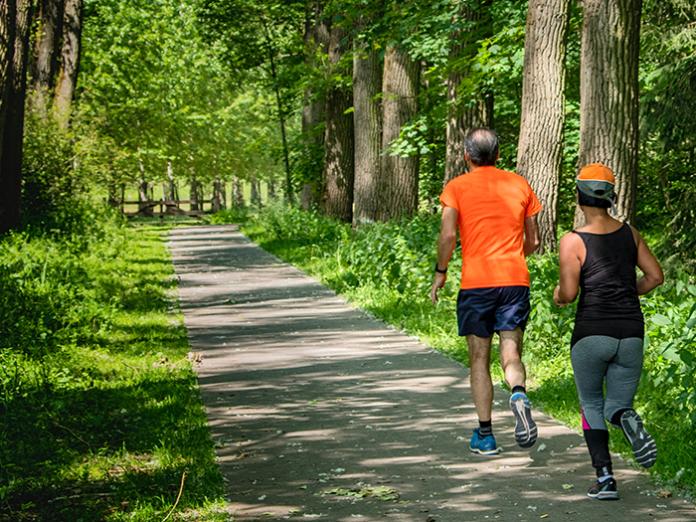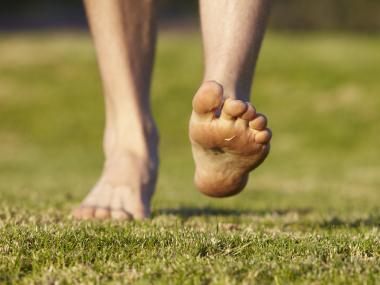Is It Better to Run Outside or on a Treadmill?
What’s the difference between walking or running overground versus on a treadmill? Dr. Jonathan Su, the Get-Fit Guy, gives you the lowdown on how treadmill momentum and uneven terrain play a role in your workout and why you should care.
Spring has finally arrived and daylight saving time has begun, which means warmer weather (at least where I live in California) and later sunsets. I’m super excited about the arrival of spring because it means more time to enjoy outdoor activities with my family even after work on weekdays.
If you’ve been walking or running indoors on a treadmill for most of the winter because it’s been cold outside or because it got dark too early, spring also means that you can finally start exercising outdoors. There’s nothing like taking in the scenery and fresh air on a nice walk or run on a beautiful day.
Walking and running are two of the most popular forms of exercise worldwide, so it’s no surprise that I’ve been getting a lot of questions recently about the difference between walking or running overground versus on a treadmill. Is one better than the other?
If you tuned in to last week’s episode on whether dumbbells, barbells, machines, or resistance bands are better for strength training, you know that my answer to these types of questions is almost always “it depends”.
Anyone who has spent time walking or running overground and on a treadmill will tell you that there’s a real difference between the two. Walking or running on a treadmill is often easier than overground as a result of two important factors: treadmill momentum and uneven terrain. Don’t worry if this is unfamiliar to you because I’ll explain it in a moment.
Even though overground walking or running is often more challenging, whether it’s better than on a treadmill depends on a host of additional factors that are unique to each person. It can also vary depending on the time of day or the context.
For example, the weather definitely plays a role and so does the relative safety of your outdoor environment. So if it’s 10 degrees or 100 degrees outside, walking or running indoors on a treadmill would be a good choice. A treadmill might also be a good choice if you live in an area with a high crime rate, with a lot of smog, or with a lot of busy streets you have to cross.
Additional considerations include how convenient it is for you to access a treadmill versus an outdoor space that’s conducive to walking or running. If you have young children like me, the only time you can exercise is before your kids wake up in the morning or after they go to sleep at night. Even though I live in the suburbs next to a nature trail, I don’t love running enough to do it in the dark with a headlamp.
With these considerations aside, there’s a real difference between walking or running overground versus on a treadmill. In this episode, I’m going to give you the lowdown on why treadmill momentum and uneven terrain makes walking or running on a treadmill often easier than walking or running overground and why you should care.
Treadmill momentum
Let’s start by talking about treadmill momentum. One important reason why walking or running on a treadmill is easier is because the treadmill belt moves to propel you backward.
The backward movement of the belt is what creates treadmill momentum and is what allows you to walk or run on a treadmill even though you’re stationary. You have to take alternating steps forward with your legs to stay on the treadmill.
The problem with the treadmill belt constantly moving backward is that you don’t have to provide as much push-off with the important glute, hamstring, and calf muscles on the back of your hips and legs.
Instead, most of the work comes from your hip flexor and quad muscles on the front of your hips and legs. This is an unnatural way of walking or running that I believe can contribute to muscle imbalances, pain, and injuries if you do too much mileage on the treadmill.
One way that most studies have attempted to compensate for treadmill momentum is to add a 1% or greater incline, but I don’t think this helps. Sure, this will make walking or running on a treadmill more challenging, but I doubt it does much to make the muscles on the back of your hips and legs work harder because it doesn’t change treadmill momentum.
In fact, I believe increasing the incline reinforces muscle imbalances by making the muscles on the front of your body work harder because now you have to lift your legs forward and up against gravity.
I’m speaking about this from experience because I actually suffered a serious strain to my right hip flexor muscles several years ago while I was training for my semi-annual U.S. Army fitness test on a treadmill. I wanted to max out the 2-mile run time and decided I was going to do that by running 3 days a week on a treadmill with a 3% incline for 6 weeks.
Everything was going as planned until I suffered the muscle strain 3 weeks in and realized that training at a 6 and half minute mile pace solely on a treadmill was not such a good idea.
Uneven terrain
Another reason walking or running on a treadmill is easier is because a treadmill lacks uneven terrain. The surface of a treadmill belt is as smooth and predictable as it gets, unlike walking or running overground.
When you walk or run outdoors, the terrain can change with every step, which stimulates more muscle fibers in your hips and legs to fire. The interesting thing is that the uneven terrain doesn’t need to be extreme to stimulate your muscle fibers to work harder.
The slight unevenness of an asphalt road surface with an occasional pebble is enough to make you notice the difference between running overground versus on a treadmill.
Again, I’m speaking about this from experience—even though I was able to achieve the max run time on a treadmill with a 3% incline, I realized after running 50 yards on asphalt during the actual fitness test that my legs felt like rubber and did not feel prepared to run outdoors.
Part of it was that asphalt is a much harder surface than the treadmill surface so my skeletal system was not used to all that ground reaction force. The other part of it was that my muscles had not been trained on uneven terrain so certain muscle fibers were being fired for the first time during the run test, which is not a good thing.
Of course, training on a treadmill also meant that I didn’t have to do much pushing off with my glute, hamstring, and calf muscles on the back of my hips and legs. Now that I was running overground, those muscles had to work and they were not having it!
So remember, there’s a real difference between walking or running overground versus on a treadmill. Even though overground walking or running is often more challenging, whether it’s better than on a treadmill depends on a host of additional factors that are unique to each person or even for the same person at different times.
I hope you can put this knowledge to use. If you have a question for me, email me at getfitguy@quickanddirtytips.com or leave me a voicemail at 510-353-3104.






